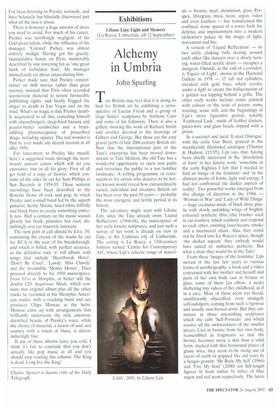Alchemy in Umbria
John Spurting
Tate Britain may feel that it is doing its best for British art by exhibiting a retrospective of Lucian Freud and a group of large Sixties' sculptures by Anthony Caro and some of his followers. There is also a gallery showing the work of Richard Smith and another devoted to the drawings of Gilbert and George. But these are the easy gravel paths of late 20th-century British art. Now that the international part of the Tate's enterprise has been moved downstream to Tate Modern, the old Tate has a wonderful opportunity to open new paths and introduce the public to a less familiar landscape. A rolling programme of retrospectives for artists who deserve to be better known would reveal how extraordinarily varied, individual and inventive British art has been over the past 50 years — probably the most energetic and fertile period in its history.
The adventure might start with Liliane Lijn, since the Tate already owns 'Liquid Reflections' (1966-68), the masterpiece of her early kinetic sculptures, and just such a survey of her work is already on view in Italy, in the Umbrian city of Umbertide. The setting is La Rocca, a 13th-century fortress turned 'Centre for Contemporary Art', where Lijn's eclectic range of materi als — bronze, steel, aluminium, glass, Perspex, fibreglass, mica, neon, argon, video and even feathers — has transformed the confined, stone spaces of a tower built for defence and imprisonment into a modern alchemist's palace by the magic of light, movement and fire.
A version of 'Liquid Reflections' — its two softly clinking balls skating around each other like dancers over a slowly turning, water-filled acrylic drum — occupies a dungeon. Outside, at the end of a corridor, is 'Figure of Light', shown in the Hayward Gallery in 1978 — 15 tall red cylinders, streaked with gold lines, which revolve under a light to create the hallucination of a golden sea lapping behind a grille. The other early works include cones painted with colours or the texts of poems, some rotating, some still, and the beginnings of Lijn's more figurative period. notably 'Feathered Lady', made of feather dusters, piano-wire and glass beads, topped with a prism.
In a succinct and lucid 'E-mail Dialogue' with the critic Guy Brett, printed in the munificently illustrated catalogue (Thames & Hudson, £15.95), Lijn says that, having been chiefly interested in the 'dissolution of form' in her kinetic work. 'sometime in the early Eighties I felt that I needed to find an image of the feminine' and 'in the abstract purity of forms, light and energy, I had not confronted the darker aspects of reality'. Two powerful works emerged from this change of direction in the 1980s — 'Woman of War' and 'Lady of Wild Things' — huge creatures made of black shiny plastic with slowly unfolding wings of brightly coloured synthetic fibre (the brushes used in car-washes), which confront and respond to each other, emitting laser-beams, smoke and a murmured chant. Alas, they could not be fitted into La Rocca's space, though 'the darker aspects' they embody would have suited its ambience perfectly. But what a draw they would be at the Tate!
From these 'images of the feminine' Lijn moved in the last few years to various forms of autobiography, a book and a video concerned with her mother and herself and parts of her own body cast in bronze or glass, some of them (an elbow, a neck) sheltering tiny videos of her childhood, as if in a cave. Most of these seem too literal, insufficiently objectified, even strangely self-indulgent, coming from such a rigorous and usually sure-footed artist. But they culminate in three astonishing sculptures which she calls 'Self-Portraits' and which resolve all the awkwardness of the smaller pieces. Cast in bronze from her own body, reassembled in fragments so that the bronze becomes more a skin than a solid torm, stacked with thin horizontal plates of glassy mica, they seem to be rising out of layers of earth or gripped like old trees by a fungus growth. 'My Body My Self' (1966) and 'Fire My Soul' (2000) are full-length figures lit from within by tubes of blue argon and red neon respectively. The latest and most dramatic of all is the half-length `Lilith' (2001), its smashed face powdered with soot. At half-hourly intervals it bursts into flame, from the solar plexus up through the divided breast, round the neck, out of the eyes and over the top of the head. But even when its gas-jets are not burning it is an overwhelming presence — part Roman, part mediaeval, part-21st century — victim, survivor and phoenix from its own ashes. In La Rocca it has a stout stone chamber to itself, but no protective barrier. Will the Tate dare to show it?































































 Previous page
Previous page